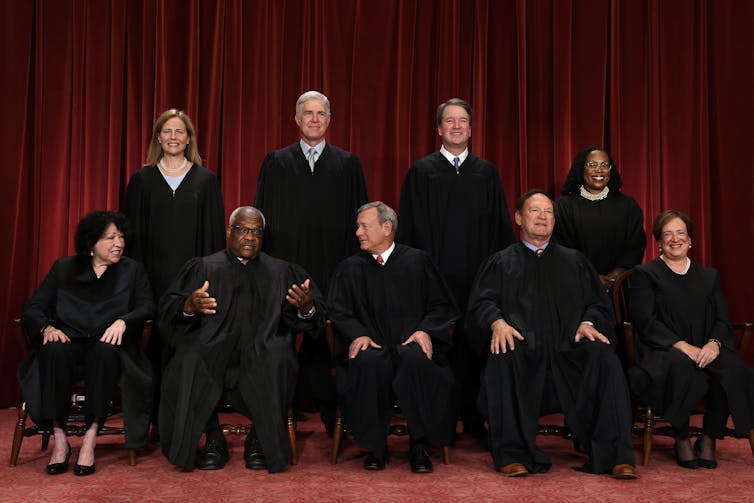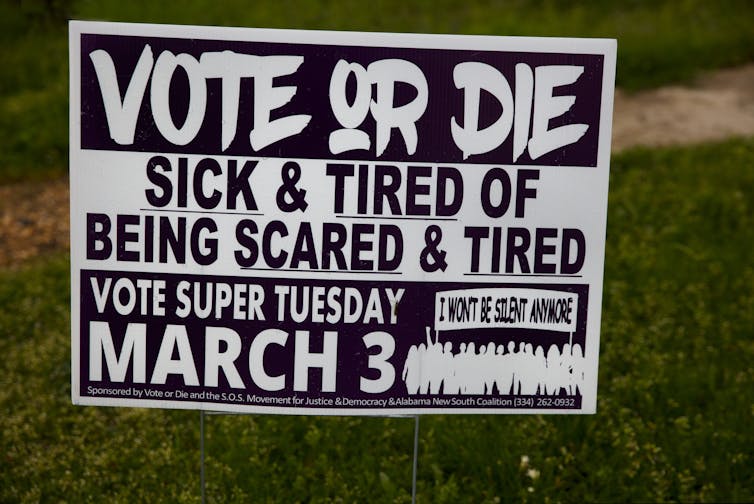For the second time in three months, the U.S. Supreme Court has rebuffed Alabama’s attempts to advance its legislature’s congressional maps that federal courts have ruled harm Black voters.
The court had first rejected the maps in its stunning June 8, 2023, decision that upheld the Voting Rights Act of 1965. But in an act of defiance, Alabama lawmakers resubmitted maps that didn’t include what the court had urged them to do – create a second political district in which Black voters could reasonably be expected to choose a candidate of their choice.
On Sept. 26, the court put those Alabama plans on hold and refused to stop a three-judge federal court panel’s plan to choose the maps Alabama will use in its 2024 elections from among a set of three maps drawn by a court-appointed special master.
One of those maps includes the creation of a second congressional district that has a majority of Black voters, and the other two would increase the percentage of Black voters in an existing district to give them a reasonable chance of electing candidates of their own choosing.
Currently, only one of Alabama’s seven congressional districts is majority Black, although Black residents make up 27% of the state’s population and voting rights advocates argued that their numbers suggest they should control at least two of the state’s congressional districts.
On Sept. 5, the panel of three federal judges rebuked the Alabama Legislature when it ruled that the state’s proposed voting districts failed to create the second Black district.
The federal judges wrote they were “deeply troubled” that Alabama lawmakers submitted a new plan that did not adhere to previous court rulings, including one issued by the U.S. Supreme Court on June 8.
“The law requires the creation of an additional district that affords Black Alabamians, like everyone else, a fair and reasonable opportunity to elect candidates of their choice,” the three judges wrote, adding that the state’s new plan “plainly fails to do so.”
A surprising decision to protect Black voters
For the 2024 elections, the federal panel of judges assigned a special master to draw three potential maps that each include two districts where Black voters have a realistic opportunity of electing their preferred candidate. Those redistricting proposals were submitted on Sept. 25, 2023.
Alabama officials have denied any wrongdoing and said their proposed voting districts, including one where the percentage of Black voters jumped from about 30% to 40%, were in compliance with recent federal court rulings.
After losing its latest appeal on Sept. 26, Alabama Attorney General Steve Marshall, a Republican, still argued that the maps the state has drawn should have been upheld by the Supreme Court.
“It is now clear that none of the maps proposed by Republican super-majorities had any chance of success,” Marshall said in a statement. “Treating voters as individuals would not do. Instead, our elected representatives and our voters must apparently be reduced to skin color alone.”
At issue in the Alabama case is whether the power of Black voters was diluted by dividing them into districts where white voters dominate.
After the 2020 census, the Republican-controlled Alabama Legislature redrew the state’s seven congressional districts to include only one in which Black voters would likely be able to elect a candidate of their choosing.
In its surprising ruling on June 8, the Supreme Court jettisoned Republican-drawn congressional districts in Alabama that a federal district court in Alabama had ruled in 2022 discriminated against Black voters and violated Section 2 of the Voting Rights Act of 1965.
The court relied on a nearly 40-year-old, seminal case, Thornburg v. Gingles, that determined a state should typically draw a majority-minority district if three conditions are met:
First, if the racial minority can be a majority in a reasonably drawn district.
Second, if the racial minority is politically cohesive, meaning that its members tend to vote together for the same candidates.
And third, if the racial minority faces bloc voting by a racial majority that tends to defeat the racial minority’s candidate of choice.

Alex Wong/.
All three conditions were true in Alabama, and the totality of the circumstances suggested minority voters did not participate equally in the political process in the area.
In his opinion, Chief Justice John Roberts explained how racially motivated voter suppression in the century after the Civil War led to the initial passage of the Voting Rights Act of 1965.
While the Supreme Court did not explicitly order the state to create a second majority-Black congressional district, Roberts made it clear how he viewed the long history of racist voter suppression in Alabama – and what factors should weigh prominently in the state’s new political map.
“A district is not equally open,” Roberts wrote, “when minority voters face – unlike their majority peers – bloc voting along racial lines, arising against the backdrop of substantial racial discrimination within the State, that renders a minority vote unequal to a vote by a nonminority voter.”
Given the Supreme Court’s recent history of restricting rights protected under the landmark Voting Rights Act of 1965 – and Roberts’ past opposition – Roberts’ opinion surprised many civil and voting rights advocates.
“States shouldn’t let race be the primary factor in deciding how to draw boundaries, but it should be a consideration,” Roberts wrote. “The line we have drawn is between consciousness and predominance.”
What Alabama did
In its case before the federal panel, the state argued that its proposed map complied with the Voting Rights Act of 1965 and the Supreme Court decision.

Barry Lewis/InPictures via .
State lawyers further argued that the Legislature was not required to create a second majority-Black district if doing so would require ignoring traditional redistricting principles, such as keeping communities of interest together.
In its decisions on Alabama’s redistricting, the Supreme Court upheld laws that were designed to protect minority voting power for the last nearly four decades.
The same is true with the three-judge court’s ruling on Sept. 5.
It reaffirmed the legal doctrine that requires jurisdictions to draw majority-minority districts in a narrow set of circumstances in which failing to do would leave minority voters unable to protect their interests through their voting power.
Given Alabama’s long-standing history of suppressing the votes of its Black citizens, the Supreme Court still may not have written its last word on race and redistricting. The court is scheduled in October 2023 to hear a similar case involving South Carolina’s voting districts.
This story has been updated from the original version published on Sept. 6, 2023.